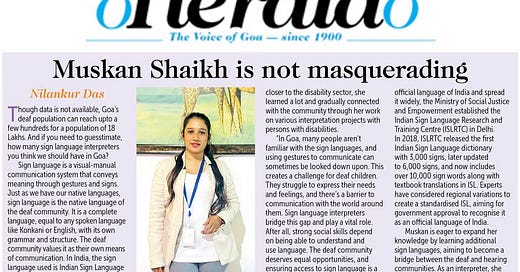Muskan Shaikh is not masquerading.
Though data is not available, Goa’s deaf population can reach upto a few thousands for a population of 18 Lakhs. And if you need to guesstimate, how many sign language interpreters you think we should have in Goa?
Sign language is a visual-manual communication system that conveys meaning through gestures and signs. Just as we have our native languages, sign language is the native language of the deaf community. It is a complete language, equal to any spoken language like Konkani or English, with its own grammar and structure. The deaf community values it as their own means of communication. In India, the sign language used is Indian Sign Language (ISL). Let us meet Muskan, she is an ISL Interpreter.
Muskan Shaikh’s mother wanted to be a teacher, but she could not, that sparked a desire in her to be a teacher, to fulfil her mother’s wishes. Sensing her aspirations, a family friend inspired her to become a special educator. And then and there Muskan’s journey began, that’s when she decided to go to Pune for a Diploma in Education (DEd) in Hearing Impairment.
She dared to be the first girl from her family to study outside of Goa. It was difficult for her for a few months dodging the barrage of questions from an extended conservative family, they were doubly doubtful as she chose to be a special educator, but she shone. Her clan is proud of her now, because she stood by her convictions, and though there are many teachers in her family, she is the only special educator that teaches people with disabilities.
During her time in Pune, Muskan lived in a hostel that was also home to many deaf children. Helping these children with their homework, she realised the critical importance of sign language for effective communication. Upon completing her DEd, Muskan moved to Mumbai to pursue a Diploma in Indian Sign Language. It was a gradual process. As she started getting closer to the disability sector, she learned a lot and gradually connected with the community through her work on various interpretation projects with persons with disabilities.
“In Goa, many people aren't familiar with the sign languages, and using gestures to communicate can sometimes be looked down upon. This creates a challenge for deaf children. They struggle to express their needs and feelings, and there's a barrier to communication with the world around them. Sign language interpreters bridge this gap and play a vital role. After all, strong social skills depend on being able to understand and use language. The deaf community deserves equal opportunities, and ensuring access to sign language is a crucial step.” Muskan opines.
She has noticed that deaf children who learn Indian Sign Language (ISL) as their first language understand concepts better. It is often difficult for the deaf to grasp lessons taught orally. However, children benefiting from cochlear implants and hearing aids are exceptions. The education system for the deaf typically follows one of three approaches: Oralism, Total Communication, or Bilingualism. Muskan believes the mode of teaching does not matter as long as the child benefits. She has noticed that many parents oppose the use of sign language, believing their child should speak instead. Consequently, they forbid their child from using sign language. However, if parents are properly informed about the benefits of ISL, they might change their views. This understanding can only be fostered by professionals such as teachers, doctors, counsellors, and advisors who interact with the parents.
To make Indian Sign Language an official language of India and spread it widely, the Ministry of Social Justice and Empowerment established the Indian Sign Language Research and Training Centre (ISLRTC) in Delhi. In 2018, ISLRTC released the first Indian Sign Language dictionary with 3,000 signs, later updated to 6,000 signs, and now includes over 10,000 sign words along with textbook translations in ISL. Experts have considered regional variations to create a standardised ISL, aiming for government approval to recognise it as an official language of India.
Muskan is eager to expand her knowledge by learning additional sign languages, aiming to become a bridge between the deaf and hearing communities. As an interpreter, she holds herself to a moral standard that prohibits her from teaching sign language directly. There are two main reasons for this stance: first, she believes in learning languages directly from their native users, in this case, the deaf themselves, who can impart the language with authenticity and beauty. Second, promoting and supporting deaf trainers enhances the quality of education and creates job opportunities for deaf individuals as trainers and educators.
She is one of the two sign language instructor in Goa. In India, there are approximately 250 certified sign language interpreters serving a deaf population estimated to be between 18 and 70 Lakhs. The wide range in population estimates stems from the fact that the Indian census does not specifically track the number of deaf individuals; instead, it records an overall count of people with disabilities. Muskan says, “If you really want to get into this field, I suggest you do not waste any more time.”
https://epaper.heraldgoa.in/oHeraldo?eid=1&edate=23/06/2024&pgid=47709&device=desktop&view=2



